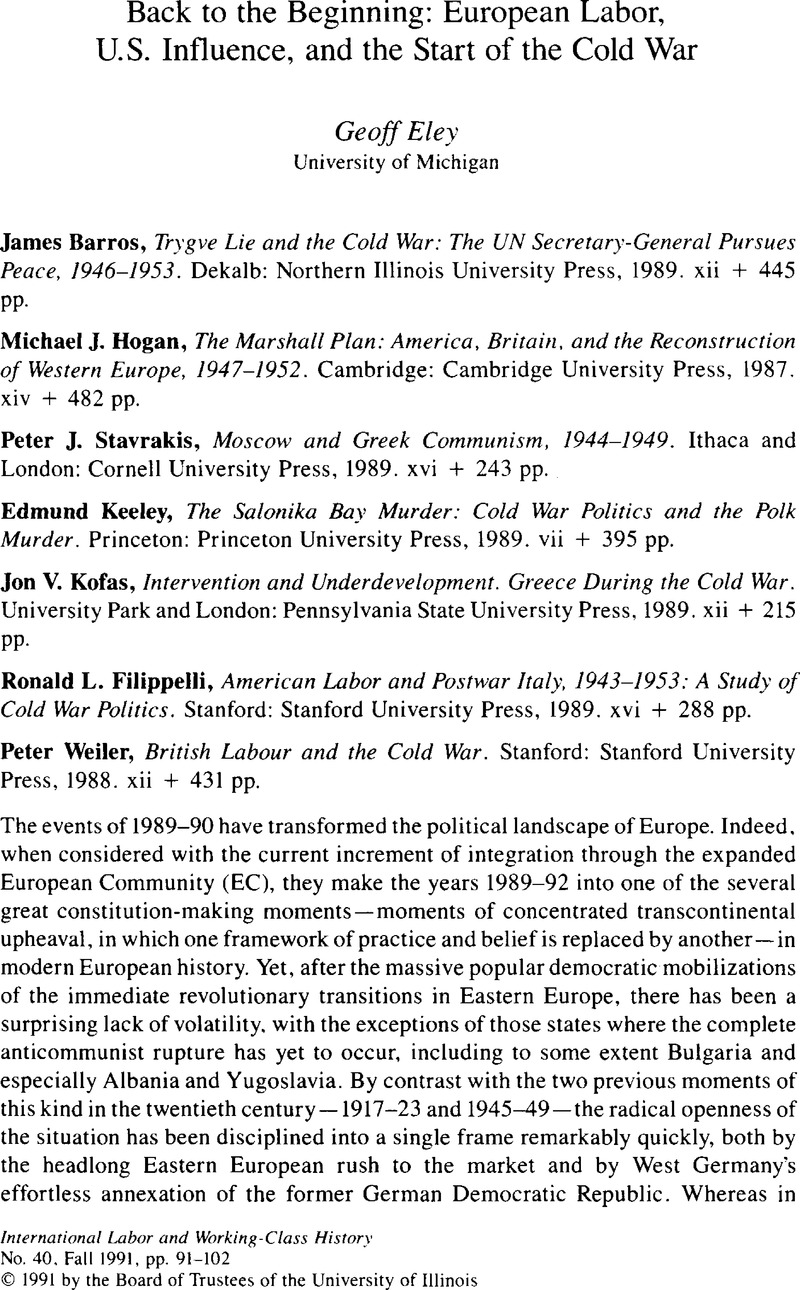Article contents
Back to the Beginning: European Labor, U.S. Influence, and the Start of the Cold War
Published online by Cambridge University Press: 16 December 2008
Abstract

- Type
- Review Essays
- Information
- Copyright
- Copyright © International Labor and Working-Class History, Inc. 1991
References
NOTES
1. Anderson, Perry, Arguments within English Marxism (London, 1980), 143.Google Scholar
2. The main alternative viewpoint is that of Milward, Alan in The Reconstruction of Western Europe, 1945–1951 (London, 1984).Google Scholar He argues that the crisis of 1947 that preceded the Marshall Plan was not one of production so much as a crisis of payments precipitated by the speed with which production had already revived; consequently, Marshall aid simply eased a recovery already generated by Europe's own resources. In a cognate argument, Charles S. Maier argues that local resources accounted for 80 to 90 percent of capital formation in the first two years of Marshall aid, and that the quantitative role of U.S. aid in Western European recovery was consequently marginal, even declining after 1949. See Maier, , “The Two Postwar Eras and the Conditions for Stability in Twentieth-Century Western Europe”, American Historial Review 86 (April 1981): 327–52.CrossRefGoogle Scholar Milward suggests that the balance of payments problem could have been handled by limiting imports to capital goods. Hogan (431) responds convincingly: “This option was not available to the fragile coalitions that presided over many of the participating countries, none of which could retreat from already low levels of consumption and hope to survive. Marshall aid enabled those coalitions to operate within a range of political choice that precluded vigorously deflationary policies, promised higher living standards, and thus closed the door to extremist elements on the Left and the Right”. It was “the ‘crucial margin’ that made European self-help possible” (432). Milward also constructs his “European self-help” argument into a distinct set of policy directions in conflict with U.S. thinking, e.g., the Schuman Plan, which he sees as “a repudiation of American policy.” Hogan is also good in disposing of this argument (439).
3. The most coherent and influential view is the one associated with the Harvard Center for European Studies. For a useful introduction, see Kesselman, Mark, Krieger, Joel et al. , European Politics in Transition (Lexington, 1987).Google Scholar
4. The trussed body of Polk was found floating in Salonika Bay with a bullet in the head. After forty-five days of torture and interrogation an ex-communist journalist called Gregory Staktopoulos confessed to the murder and was convicted during a rigged trial. While the evidence stops short of identifying the real murder story, it is beyond dispute that U.S. and British officials connived in the frame-up, that Polk's demise was far more convenient for the Right than for the communists (to whom he was quite sympathetic), and that the Western press fully participated in the cover-up.
5. On May 27, 1947, Alcide De Gasperi, the Christian Democratic Italian premier, met with the U.S. ambassador and made this direct relationship crystal clear. “What he needed for the survival of the new single party government, if he undertook it, was some new and substantial evidence of economic aid which could be supplied to the support of the lira and the financial position of the government.” With that support–described by another spokesman as “something spectacular” to offer the Italian people–De Gasperi felt able to confront the Left. He had in mind a direct allocation of aid to Italy, but the Marshall Plan unexpectedly announced a few days later functionally did the trick. See Harper, John Lamberton, America and the Reconstruction of Italy, 1945–1948 (Cambridge, 1986), 133.CrossRefGoogle Scholar
6. Two further books should be mentioned, which appeared too late for inclusion in this review but which continue the historiographical work represented here by Weiler and Filippelli and indeed carry it further in a welcome social-historical direction: Chapman, Herrick, State Capitalism and Working-Class Radicalism in the French Aircraft (Berkeley, 1991);Google Scholar and Wall, Irwin M., The United States and the Making of Postwar France, 1945–1954 (Cambridge, 1991).CrossRefGoogle Scholar Wall's work originally appeared in a French edition, L'influence américaine sur la politique française 1945–1954 (Paris, 1989).Google Scholar
- 2
- Cited by


